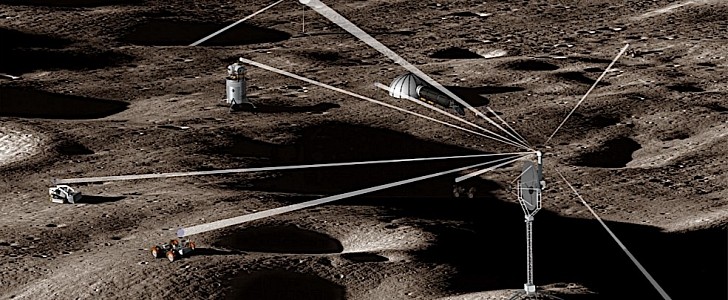Given how NASA has made it its goal to land on the Moon and eventually become a resident there, countless companies and individuals have begun working on technologies to back this ambitious plan. And a lot of crazy ideas come through the NASA Innovative Advanced Concepts (NIAC) program announced a couple of months ago.
We’ve already covered most of the ideas backed by the American space agency through this program, but the one we have here today is nothing short of brilliant. In a literal sense, as it is all about bending and beaming light.
What you’re looking at is called Light Bender, and it is the brainchild of Charles Taylor from the NASA Langley Research Center. It is a piece of hardware meant to generate and distribute solar light across the Moon’s surface, where it should be captured and converted into electricity.
Light Bender comprises a heliostat that uses Cassegrain telescope optics (hardware comprising a primary concave mirror and a secondary convex mirror), meant to catch and focus the light thrown at it by the Sun, and a Fresnells lens (made of successive concentric lens elements) meant to collimate the captured light and send it on its merry way.
The thing is supposed to work a bit like this: light hits the heliostat, gets focused, and sent in all and any direction for distances as long as 1 km (0.62 miles). Taylor says this should happen without substantial losses, and the light should be captured at the receiving end by solar arrays measuring 2 to 4 meters (6.5 to 13 feet). The Light Bender should be capable of capturing almost 48 kWe of sunlight, but given how the system is scalable, that amount could vary.
The main advantages of such a system would be the lack of cables needed for the transportation of light, but also that it could send light even in places on the Moon where the Sun never shines.
The technology is still in its infancy, and as with all NIAC projects, there’s no guarantee this will end up being used by NASA.
What you’re looking at is called Light Bender, and it is the brainchild of Charles Taylor from the NASA Langley Research Center. It is a piece of hardware meant to generate and distribute solar light across the Moon’s surface, where it should be captured and converted into electricity.
Light Bender comprises a heliostat that uses Cassegrain telescope optics (hardware comprising a primary concave mirror and a secondary convex mirror), meant to catch and focus the light thrown at it by the Sun, and a Fresnells lens (made of successive concentric lens elements) meant to collimate the captured light and send it on its merry way.
The thing is supposed to work a bit like this: light hits the heliostat, gets focused, and sent in all and any direction for distances as long as 1 km (0.62 miles). Taylor says this should happen without substantial losses, and the light should be captured at the receiving end by solar arrays measuring 2 to 4 meters (6.5 to 13 feet). The Light Bender should be capable of capturing almost 48 kWe of sunlight, but given how the system is scalable, that amount could vary.
The main advantages of such a system would be the lack of cables needed for the transportation of light, but also that it could send light even in places on the Moon where the Sun never shines.
The technology is still in its infancy, and as with all NIAC projects, there’s no guarantee this will end up being used by NASA.

